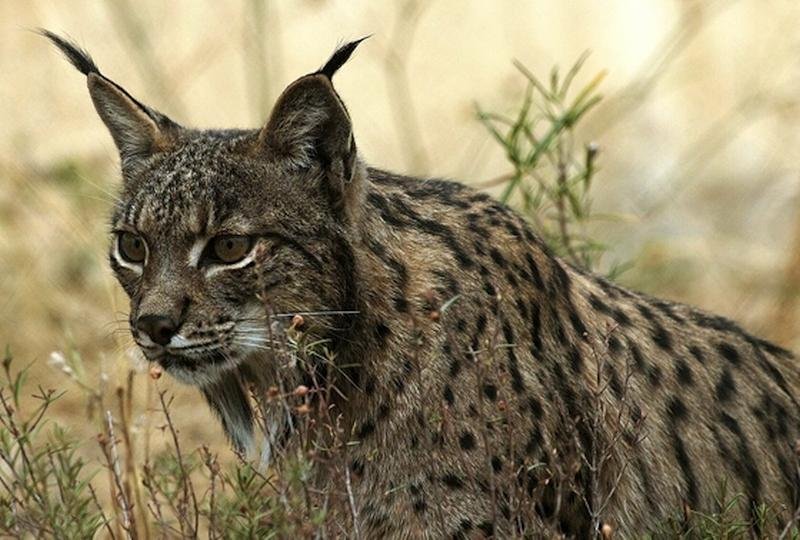From the most endangered cat species in the world to a success story for managed wildlife protection schemes, the reintroducion of the Iberian lynx to Catalonia and Aragon seems to be the next step forward with the project being supported by the Spanish Government and an area of around 30,000 hectares being studied for suitability.
The Iberian lynx (Lynx pardinus) has been absent from Catalonia and Aragon for over a century but in 2018 an introduced lynx called “Litio” managed to reach Santa Coloma de Cervelló just 15 minutes from Barcelona, after making a seemingly impossible 1000 km journey crossing motorways, rivers and mountains from the Portuguese Algarve.
“Litio” was later captured (in lynx heaven one supposes) on a farm surrounded by rabbits and cherry trees and returned to Doñana (Huelva), where the species has one of its largest populations.
There are two main areas of studies for this project with the first being a suitable habitat with food supply (rabbits) for the reintroduction of the species in an area that includes 10,000 hectares of Aragón and 20,000 in Catalonia and the second (being larger and more difficult) with the study and implementation of wildlife “corridors” connecting some of the eastern Iberian populations of lynx.
Reintroduction habitat
The initial field work in both Catalonia and Aragón has located possible ideal habitats, with an abundance of prey such as rabbits, shelters such as rock and scrub and with little human infrastructure. In Catalonia the location is the Mas Melons-Alfés area, a natural space already protected by the Natura 2000 network, between the Garrigues and Segrià regions south of Lleida and adjacent to Aragón. In Aragón the chosen area is the Sierra de Alcubierre, located at the western limit of Los Monegros. (Los Monegros is also being studied for posible inclusion as national Park)
Wildlife corridors and project coperation
The initial idea would be to create a corridor from the east, linking the regions of Valencia, Murcia, Catalonia and Aragón. The plan is also to cooperate with existing and new lynx projects such as the two new lynx re introduction areas, one in Lorca (Murcia) and the other in Sierra Arana (Granada) which already have funding of almost 20 million euros over the next five years. (In Valencia, there is also a project run by the Cardenal Herrera University to study the viability of lynx reintroductions in the Valencian Community).
It seems that all the experts are agreeing that the only way forward now for the Iberian Lynx is the natural mixing of the various lynx populations across Iberia in order to ensure a complete genetic diversity of the species.
Further reading on the Reintroducion of Iberian lynx to Catalonia and Aragon
The PreLynxCatAr project will 12 months and in its preliminary phase the suitability of the territory, already defined, will be studied to assess the risks (such as roads) and its population of rabbits. It is being carried out by CBD-Hábitat, CREW Foundation, Trenca, Zoo de Barcelona and the Fundación Biodiversidad del Ministerio para la Transición Ecológica y el Reto Demográfico del Gobierno de España.
Article in Spanish here (El Pais): https://elpais.com/clima-y-medio-ambiente/2021-07-23/el-lince-iberico-se-acerca-a-cataluna-y-aragon.html
Read more about the Iberian Lynx here: https://wildsideholidays.co.uk/iberian-lynx-lynx-pardinus-lince-iberico/
Iberia Nature Forum
Discover the Iberia Nature Forum – Environment, geography, nature, landscape, climate, culture, history, rural tourism and travel.
Iberia Nature Forum: https://iberianatureforum.com/
I’ve been living in this lovely area of Western Andalucia for the last 20 years or so and dedicate most of my time to the running of English language tourist information websites for the towns of Cádiz, Ronda, Grazalema, the famous or infamous Caminito del Rey, and also Wildside Holidays, which promotes sustainable and eco-friendly businesses running wildlife and walking holidays in Spain. My articles contain affiliate links that will help you reserve a hotel, bus, train or activity in the area. You don’t pay more, but by using them you do support this website. Thankyou!
